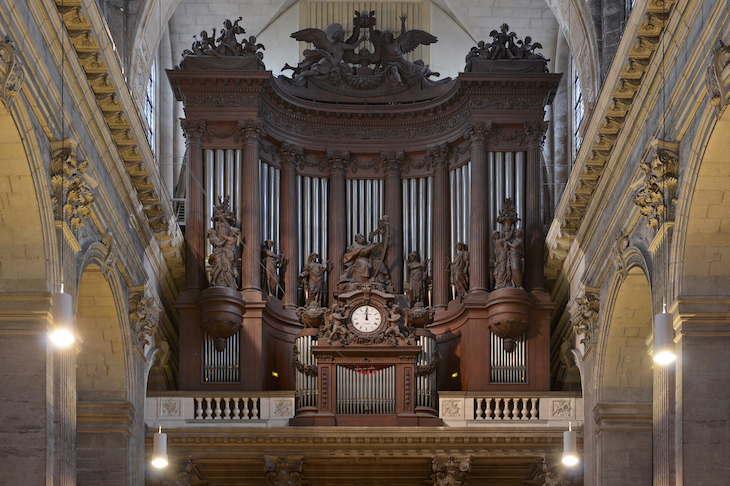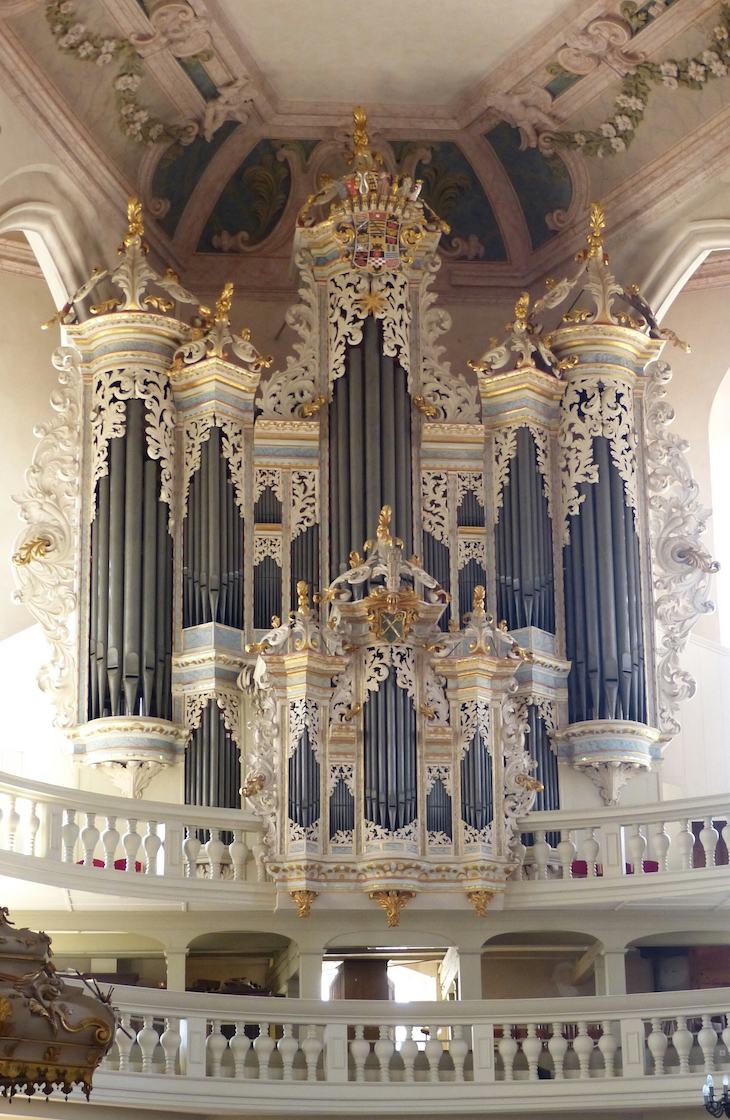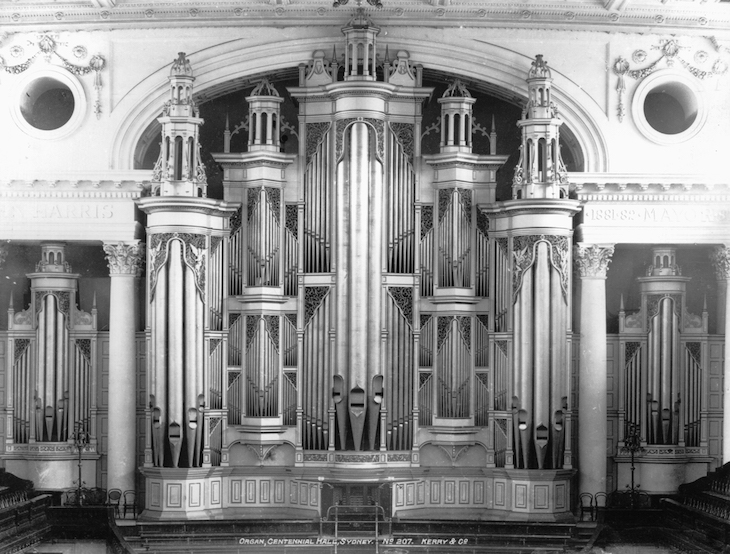Organs have been in the news this summer. The cathedral organ at Nantes was wholly destroyed by fire on 18 July, apparently a case of arson. More recently, work has started in Paris to dismantle the instrument at Notre-Dame, which survived the fire in 2019, but now needs a lot of care and attention.
The Nantes organ was widely described as dating from 1621, and that at Notre-Dame is often termed ‘historic’. Of course, things are more complicated than that. Organs are often palimpsests. At Nantes, while the organ case dated from the 17th century, the instrument also contained thousands of pipes made in the 1780s by the royal organ builder François-Henri Clicquot (1732–90); large parts of the instrument actually dated from 1970.
By contrast the organ at Cathédrale Saint-Pierre, Poitiers, also by the Clicquot firm, is largely unaltered. It is a thrilling instrument to play; sitting at the keys feels like being in a time machine that has transported the player back to pre-Revolutionary France. As one would expect, French baroque organs have a highly stylised and codified aesthetic. They must be approached on their own terms. In the immense acoustic of the 12th-century cathedral, the Poitiers organ is truly sublime. By contrast, Saint-Sulpice in Paris carries us back to the urbane world of the organist and composer Charles-Marie Widor (1844–1937). The instrument there is the masterpiece of Aristide Cavaillé-Coll (1811–90), the greatest organ builder of the 19th century. Completed in 1862, it is an astonishing piece of Second Empire engineering, its 102 stops still played from the original five-manual console, the 19th-century mechanical and pneumatic machinery lovingly tended. It is also a marvellous musical instrument, superbly played to this day by inspirational resident organists.

The great organ in the church of Saint-Sulpice, Paris, originally constructed by François-Henri Clicquot in 1781, and reconstructed by Aristide Cavaillé-Coll in 1862. Photo: Wikimedia Commons/Selbymay; used under Creative Commons licence (CC BY-SA 3.0)
Organs vary greatly across Europe. Spain and Italy have their own very distinctive styles. The great monastic organs of southern Germany are in every way the musical equivalent of a princely Wunderkammer. The Netherlands has dozens of important instruments, some dating from the 16th and 17th centuries, cousins of similar organs across northern Europe. One of the greatest, in the Grote Kerk at Alkmaar, is not only one of the finest organs in the world, but is housed in a monumental case designed by Jacob van Campen and dating to 1645. Around 90 per cent of the pipes and mechanism date from a reconstruction in 1723–25, or are earlier.
In Lutheran Germany, organs were primarily meant to accompany chorales, but also inspired a distinguished organ-playing tradition, in which an ability to use your feet is particularly important. One of most awe-inspiring instruments is in the Stadtkirche St Wenzel in Naumburg, built by the Leipzig-based organ builder Zacharias Hildebrandt (1688–1757), and formally inspected and signed off by J.S. Bach in 1746. Visiting in 2008, having been sternly enjoined not to poke the paper stop labels (someone might have touched them), I was given the key and asked to drop it off later at the local pizza restaurant. Then there are many village organs, some scarcely altered, like the organ of 1741 at Grosshartmannsdorf in Saxony, built by Hildebrandt’s rival Gottfried Silbermann (1683–1753). This, too, feels like a musical time machine.

The organ in the Stadtkirche St Wenzel in Naumburg, built by Zacharias Hildebrandt in the 1740s. Photo: Wikimedia Commons/GUMPi; used under a Creative Commons licence (CC BY-SA 4.0)
The idea that an organ can be an historic monument is well established in most European countries, with separate levels of classification for cases and innards, and with some element of direct or indirect public funding for maintenance and conservation. In Australia, too, organs are taken very seriously as heritage assets. The vast organ in Sydney Town Hall, built by William Hill & Son in 1890, is widely regarded to be the greatest organ ever built in Britain. It certainly has a magnificent neo-Renaissance case, designed by Arthur Hill (1857–1923), an organ-building Fellow of the Society of Antiquaries, and author of an important book on early organ cases. Like Saint-Sulpice – but unlike Notre-Dame, or many Victorian organs in Britain – the Sydney organ has been jealously protected over many decades from those who thought it could be ‘modernised’ or ‘improved’.

The organ in Sydney Town Hall, built by William Hill & Son in 1890. Photo: Flickr/Tyrrell Photographic Collection, Powerhouse Museum
Things are often considerably less rosy in Britain. Few early instruments survive – seen off by the Civil War, the Oxford movement, and too much money in the wrong places at the wrong times. One notable exception is the organ at Christ Church, Spitalfields, which dates to 1734. The largest organ built in 18th-century England, it was triumphantly restored by the late William Drake, a project that began in 2000, and took 15 years to plan and bring to fruition. However, many of the finest historic instruments date from the late 19th and early 20th centuries (that in the great hall at Kelvingrove in Glasgow and the superb Henry Willis organ at Reading Town Hall have been meticulously restored in recent years). But there is no statutory listing system – a bizarre anomaly, about which the British Institute of Organ Studies (the SPAB of organs) has been lobbying for years. In theory organs in Anglican churches should be protected by the faculty system. In practice that is not always the case. A better system of heritage protection for historic organs is certainly long overdue.
Mark Purcell is Deputy Director for Research Collections at Cambridge University Library, and Bye-Fellow at Pembroke College. A specialist on the history of libraries, he is also interested in historic organs, and is a former Oxford and cathedral organ scholar.

In praise of organs
The great organ at the Grote Kerk, Alkmaar, dating to 1645 and housed in a case designed by Jacob van Campen. Photo: Lucien Kroon
Share
Organs have been in the news this summer. The cathedral organ at Nantes was wholly destroyed by fire on 18 July, apparently a case of arson. More recently, work has started in Paris to dismantle the instrument at Notre-Dame, which survived the fire in 2019, but now needs a lot of care and attention.
The Nantes organ was widely described as dating from 1621, and that at Notre-Dame is often termed ‘historic’. Of course, things are more complicated than that. Organs are often palimpsests. At Nantes, while the organ case dated from the 17th century, the instrument also contained thousands of pipes made in the 1780s by the royal organ builder François-Henri Clicquot (1732–90); large parts of the instrument actually dated from 1970.
By contrast the organ at Cathédrale Saint-Pierre, Poitiers, also by the Clicquot firm, is largely unaltered. It is a thrilling instrument to play; sitting at the keys feels like being in a time machine that has transported the player back to pre-Revolutionary France. As one would expect, French baroque organs have a highly stylised and codified aesthetic. They must be approached on their own terms. In the immense acoustic of the 12th-century cathedral, the Poitiers organ is truly sublime. By contrast, Saint-Sulpice in Paris carries us back to the urbane world of the organist and composer Charles-Marie Widor (1844–1937). The instrument there is the masterpiece of Aristide Cavaillé-Coll (1811–90), the greatest organ builder of the 19th century. Completed in 1862, it is an astonishing piece of Second Empire engineering, its 102 stops still played from the original five-manual console, the 19th-century mechanical and pneumatic machinery lovingly tended. It is also a marvellous musical instrument, superbly played to this day by inspirational resident organists.
The great organ in the church of Saint-Sulpice, Paris, originally constructed by François-Henri Clicquot in 1781, and reconstructed by Aristide Cavaillé-Coll in 1862. Photo: Wikimedia Commons/Selbymay; used under Creative Commons licence (CC BY-SA 3.0)
Organs vary greatly across Europe. Spain and Italy have their own very distinctive styles. The great monastic organs of southern Germany are in every way the musical equivalent of a princely Wunderkammer. The Netherlands has dozens of important instruments, some dating from the 16th and 17th centuries, cousins of similar organs across northern Europe. One of the greatest, in the Grote Kerk at Alkmaar, is not only one of the finest organs in the world, but is housed in a monumental case designed by Jacob van Campen and dating to 1645. Around 90 per cent of the pipes and mechanism date from a reconstruction in 1723–25, or are earlier.
In Lutheran Germany, organs were primarily meant to accompany chorales, but also inspired a distinguished organ-playing tradition, in which an ability to use your feet is particularly important. One of most awe-inspiring instruments is in the Stadtkirche St Wenzel in Naumburg, built by the Leipzig-based organ builder Zacharias Hildebrandt (1688–1757), and formally inspected and signed off by J.S. Bach in 1746. Visiting in 2008, having been sternly enjoined not to poke the paper stop labels (someone might have touched them), I was given the key and asked to drop it off later at the local pizza restaurant. Then there are many village organs, some scarcely altered, like the organ of 1741 at Grosshartmannsdorf in Saxony, built by Hildebrandt’s rival Gottfried Silbermann (1683–1753). This, too, feels like a musical time machine.
The organ in the Stadtkirche St Wenzel in Naumburg, built by Zacharias Hildebrandt in the 1740s. Photo: Wikimedia Commons/GUMPi; used under a Creative Commons licence (CC BY-SA 4.0)
The idea that an organ can be an historic monument is well established in most European countries, with separate levels of classification for cases and innards, and with some element of direct or indirect public funding for maintenance and conservation. In Australia, too, organs are taken very seriously as heritage assets. The vast organ in Sydney Town Hall, built by William Hill & Son in 1890, is widely regarded to be the greatest organ ever built in Britain. It certainly has a magnificent neo-Renaissance case, designed by Arthur Hill (1857–1923), an organ-building Fellow of the Society of Antiquaries, and author of an important book on early organ cases. Like Saint-Sulpice – but unlike Notre-Dame, or many Victorian organs in Britain – the Sydney organ has been jealously protected over many decades from those who thought it could be ‘modernised’ or ‘improved’.
The organ in Sydney Town Hall, built by William Hill & Son in 1890. Photo: Flickr/Tyrrell Photographic Collection, Powerhouse Museum
Things are often considerably less rosy in Britain. Few early instruments survive – seen off by the Civil War, the Oxford movement, and too much money in the wrong places at the wrong times. One notable exception is the organ at Christ Church, Spitalfields, which dates to 1734. The largest organ built in 18th-century England, it was triumphantly restored by the late William Drake, a project that began in 2000, and took 15 years to plan and bring to fruition. However, many of the finest historic instruments date from the late 19th and early 20th centuries (that in the great hall at Kelvingrove in Glasgow and the superb Henry Willis organ at Reading Town Hall have been meticulously restored in recent years). But there is no statutory listing system – a bizarre anomaly, about which the British Institute of Organ Studies (the SPAB of organs) has been lobbying for years. In theory organs in Anglican churches should be protected by the faculty system. In practice that is not always the case. A better system of heritage protection for historic organs is certainly long overdue.
Mark Purcell is Deputy Director for Research Collections at Cambridge University Library, and Bye-Fellow at Pembroke College. A specialist on the history of libraries, he is also interested in historic organs, and is a former Oxford and cathedral organ scholar.
Unlimited access from just $16 every 3 months
Subscribe to get unlimited and exclusive access to the top art stories, interviews and exhibition reviews.
Share
Recommended for you
The grand gestures hiding in Parisian churches
Religious art didn’t die out in the 18th century – Parisian churches are full of large-scale baroque paintings
The unsung art of Milein Cosman
Cosman was a fine portraitist who captured the leading cultural figures of her time
How the only portrait Beethoven posed for in his lifetime became a much coveted memento
For the past two centuries, Joseph Karl Stieler’s portrait of the composer has been highly sought after by music lovers